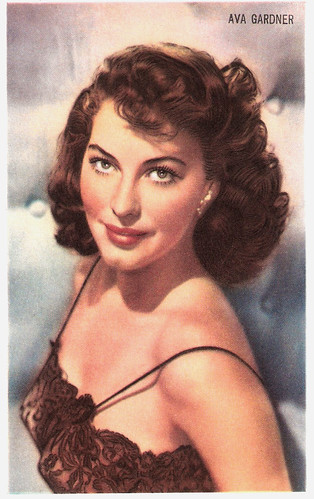
Belgian collectors card by Kwatta, Bois d'Haine, no. C 234. Photo: M.G.M. Publicity still for East Side, West Side (Mervyn LeRoy, 1949).
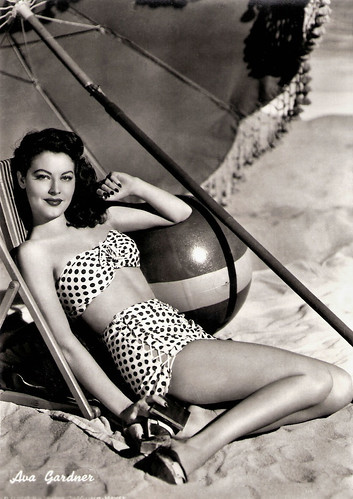
Italian postcard by Bromofoto, Milano, no. 224.

Italian postcard by Rotalfoto, Milano, no. 500. Ava Gardner.
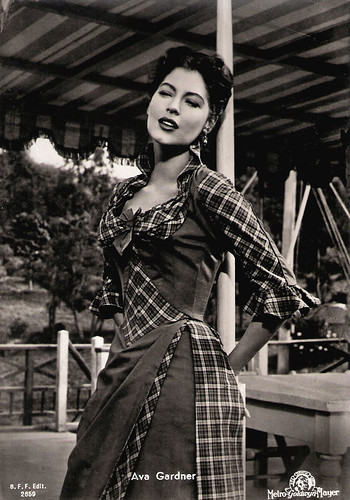
Italian postcard by B.F.F. (Casa Edit. Ballerini & Fratini), Milano, no. 2659. Photo: Metro-Goldwyn-Mayer. Publicity still for Show Boat (George Sidney, 1951).

British Greetings card, no. D. Photo: Virgil Apger / Metro Goldwyn Mayer.

French postcard, no. 116. Photo: Virgil Apger.
She can't sing, she can't act, she can't talk, she's terrific!
Ava Lavinia Gardner was born in 1922 near the farming community of Smithfield, North Carolina, USA. She was the youngest of seven children of Mary Elizabeth ‘Molly’ (Baker) and Jonas Bailey Gardner, poor cotton and tobacco farmers. While the children were still young, the Gardners lost their property, forcing Jonas Gardner to work at a sawmill and Molly to begin working as a cook and housekeeper at a dormitory for teachers at the nearby Brogden School.
When Gardner was seven years old, the family decided to try their luck in Newport News, Virginia, where Molly Gardner found work managing a boarding house for the city's many ship workers. While in Newport News, Gardner's father became ill and died from bronchitis in 1938, when Ava was 15 years old. After Jonas Gardner's death, the family moved to Rock Ridge near Wilson, North Carolina, where Mollie Gardner ran another boarding house for teachers. Gardner attended high school in Rock Ridge and she graduated from there in 1939. She then attended secretarial classes at Atlantic Christian College in Wilson for about a year.
Gardner was visiting her sister Beatrice in New York in 1941 when Beatrice's husband Larry Tarr, a professional photographer, offered to take her portrait. He was so pleased with the results that he displayed the finished product in the front window of his Tarr Photography Studio on Fifth Avenue. The Tarrs sent her picture to Metro Goldwyn Mayer and Ava was interviewed at MGM's New York office by Al Altman, head of MGM's New York talent department. With cameras rolling, he directed the eighteen-year-old to walk towards the camera, turn and walk away, and then rearrange some flowers in a vase. He did not attempt to record her voice because her Southern accent made it almost impossible for him to understand her. Louis B. Mayer, head of the studio, however, sent a telegram to Al: "She can't sing, she can't act, she can't talk, She's terrific!"
Ava was offered a standard contract by MGM and left school for Hollywood in 1941 with her sister Beatrice accompanying her. MGM's first order of business was to provide her a speech coach, as her Carolina drawl was nearly incomprehensible to them. Soon after she arrived in Los Angeles, Gardner met fellow MGM contract player Mickey Rooney. They married in 1942 when she was 19 years old and he was 21. Largely due to Rooney's serial adultery, Gardner divorced him in 1943 but agreed not to reveal the cause so as not to affect his career. Gardner's second marriage was brief as well, to jazz musician and bandleader Artie Shaw, from 1945 to 1946.
Till then, she had appeared in 17 film roles, but mainly one-line bits or little better. She had her first bigger role in the B-film Whistle Stop (Léonide Moguy 1946) starring George Raft. Then, MGM loaned her to Universal for the Film Noir The Killers (Robert Siodmak, 1946), based on a story by Ernest Hemingway. Her performance as an incredibly beautiful femme fatale opposite Burt Lancaster became her breakthrough. The Killers became a smash hit and Gardner was an instant star.
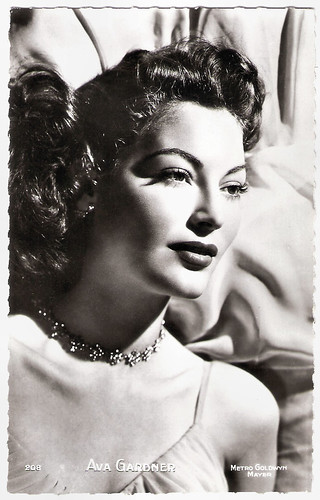
French postcard by Editions P.I., La Garenne-Colombes, no. 208, 1950. Photo: Metro-Goldwyn-Mayer.

Spanish postcard by Belfo, no. 133. Ava Gardner and Fred MacMurray in Singapore (John Brahm, 1947). Collection: Marlene Pilaete.

German postcard. Photo: Universal International Pictures. Ava Gardner in One Touch of Venus (William A. Seiter, 1948).
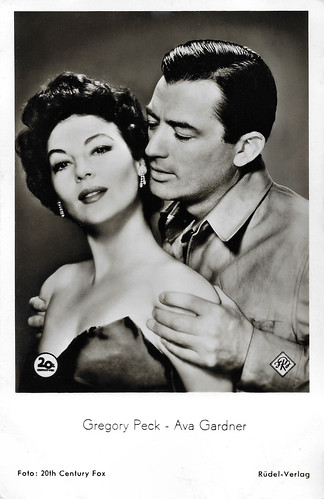
West-German postcard by Rüdel-Verlag, Hamburg-Bergedorf, no. 507. Photo: 20th Century Fox. Ava Gardner and Gregory Peck in The Snows of Kilimanjaro (Henry King, 1952).

Yugoslavian postcard by Sedma Sila. Photo: IOM, Beograd. Robert Taylor and Ava Gardner in Knights of the Round Table (Richard Thorpe, 1953).
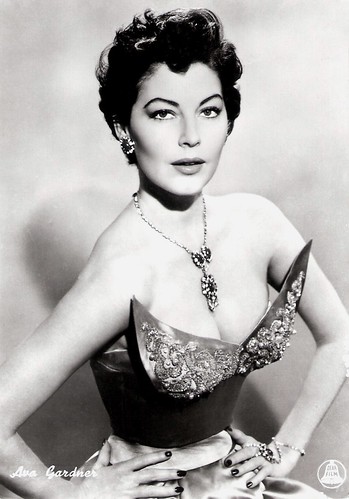
Italian postcard by Bromofoto, Milano, no. 881. Photo: Dear Film. Publicity still for The Barefoot Contessa (Joseph L. Mankiewicz, 1954).
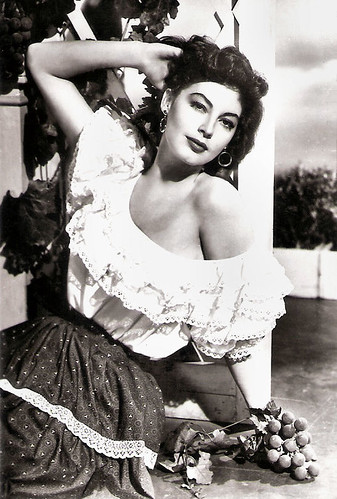
Vintage collector's card. Photo: MGM. Publicity still for The Barefoot Contessa (Joseph L. Mankiewicz, 1954).
A fan of bullfighting and bullfighters
Ava Gardner became more and more prominent with her next films, including The Hucksters (Jack Conway, 1947) with Clark Gable, the musical Show Boat (George Sidney, 1951), and The Snows of Kilimanjaro (Henry King, 1952). In 1951, Frank Sinatra left his wife, Nancy, for Gardner, and their subsequent marriage, her third and last, made headlines. The tumultuous marriage ended in 1957, but Gardner remained good friends with Sinatra for the remainder of her life. She would later say in her autobiography Ava: My Story, that he was the love of her life.
In 1953, Ava was nominated for the Academy Award for Best Actress for her work in Mogambo (John Ford, 1953). She appeared in several more high-profile films during the 1950s, including The Barefoot Contessa (Joseph L. Mankiewicz, 1954), Bhowani Junction (George Cukor, 1956), and The Sun Also Rises (Henry King, 1957). After Gardner divorced Sinatra in 1957, she headed for Spain, where she began a friendship with writer Ernest Hemingway, the author of The Sun Also Rises. Several years earlier, Hemingway had successfully urged producer Darryl F. Zanuck to cast Gardner in The Snows of Kilimanjaro (1952), which adapted several of his short stories. Her friendship with Hemingway led to her becoming a fan of bullfighting and bullfighters, such as Luis Miguel Dominguín, who became her lover.
Most of her subsequent films were outside the US. In 1963, Gardner was billed between Charlton Heston and David Niven in the historical epic 55 Days at Peking (Nicholas Ray, 1963), which was set in China during the Boxer Rebellion in 1900. The following year, she played her last great leading role as Maxine Faulk in the critically acclaimed The Night of the Iguana (John Huston, 1964). The film, based upon a Tennessee Williams play, starred Richard Burton as an atheist clergyman and Deborah Kerr as a gentle artist travelling with her aged poet grandfather. Gardner was nominated for a BAFTA and a Golden Globe award for her hearty performance in this signature role.
Gardner next appeared again with Burt Lancaster in Seven Days in May (John Frankenheimer, 1964), a fascinating thriller based on a script by Rod Sterling about an attempted military takeover of the US government. In 1968, tax trouble in Spain prompted her to move to London. There she underwent an elective hysterectomy to allay her worries of contracting uterine cancer that had claimed the life of her own mother. That year, she made what some consider to be one of her Empress Elisabeth of Austria opposite James Mason as Emperor Franz Joseph I.
She appeared in several disaster films throughout the 1970s, notably Earthquake (Mark Robson, 1974) with Charlton Heston, the Italian-British disaster-thriller The Cassandra Crossing (George Pan Cosmatos, 1976) with Richard Harris and Sophia Loren, and the Canadian film City on Fire (Alvin Rakoff, 1979). She appeared briefly as legendary actress Lillie Langtry at the end of The Life and Times of Judge Roy Bean (John Huston, 1972) featuring Paul Newman, and in the American/Soviet fantasy film The Blue Bird (George Cukor, 1976). Her last film was Regina Roma (Jean-Yves Prate, 1982), with Anthony Quinn and Anna Karina. In the 1980s Ava Gardner acted primarily on television, including the mini-series remake of The Long, Hot Summer (Stuart Cooper, 1985), based on the novel by William Faulkner. She continued to act regularly until 1986 when two strokes left her partially paralyzed and bedridden. Four years later, Ava Gardner died of pneumonia at the age of 67, at her London home, where she had lived since 1968.
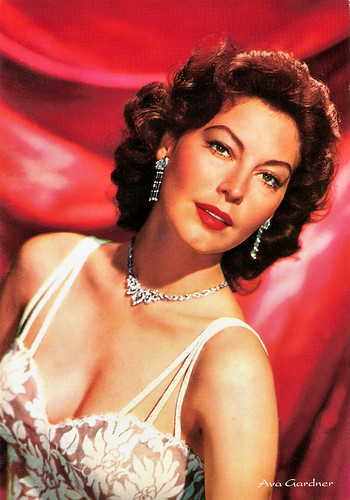
Italian postcard in the series Artisti di Sempre by Rotalfoto, Milano, no. 299.
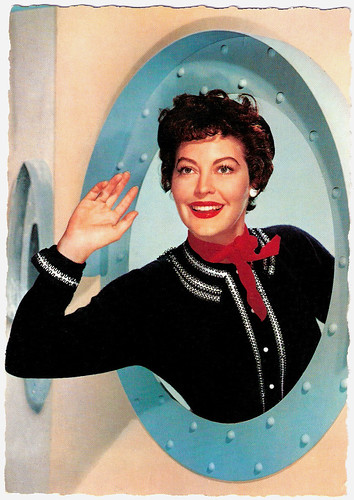
French postcard by E.D.U.G., no. 48.
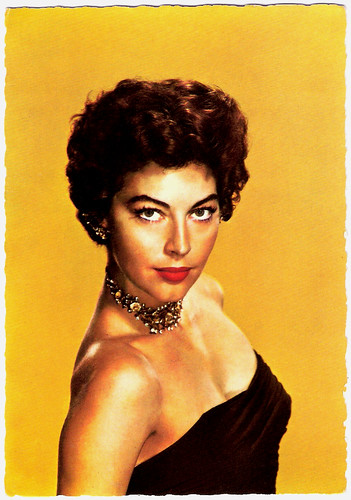
French postcard by E.D.U.G., no. 126.
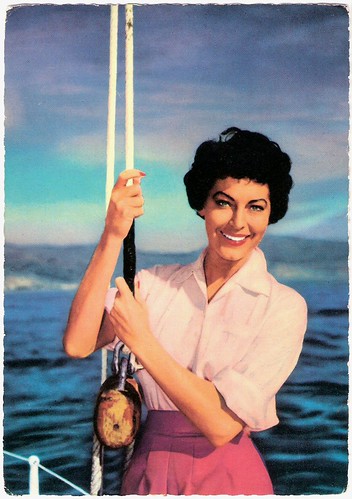
German postcard by ISV, no. D 4. Photo: Civiani.
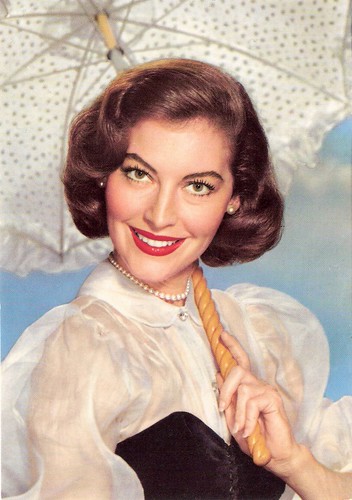
Italian postcard by Rotalcolor (Rotalfoto), Milano (Milan), no. 13.

Italian postcard by Rotalcolor, Milano, no. 124.

Russian postcard. Photo: Oleg Popov, Ava Gardner, and Todd Lookinland in The Blue Bird (George Cukor, 1976).
Sources: Rod Crawford (IMDb), Wikipedia, and IMDb.
This post was last updated on 4 May 2024.
No comments:
Post a Comment